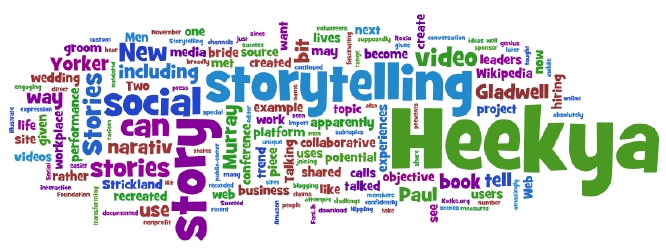Here’s this week’s A Storied Career word/tag cloud from Wordle.net, produced during Tropical Storm Fay after four straight days of rain:
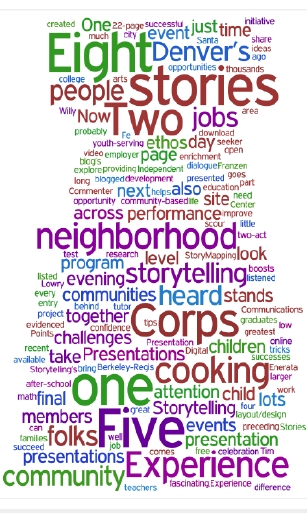
Stories of Boomers Meeting the Greatest Community Challenges
Experience Corps, an award-winning national program, engages people over 55 in meeting their communities’ greatest challenges. Today, in 21 cities across the country, 2,000 Experience Corps members tutor and mentor elementary school students, help teachers in the classroom, and lead after-school enrichment activities. Independent research shows that Experience Corps boosts student academic performance, helps schools and youth-serving organizations become more successful, and enhances the well-being of the older adults in the process. 
The Experience Corps site provides the opportunity for Experience Corps members, educators, and families to share their stories about the program. Here’s a sample:
I had a child in my class who had very low self confidence. He listened when he heard me say, “Now you’re cooking,” to children who were doing very well. When the other children heard this they paid more attention to how they did their work. When we test on math and reading and grade their paper they will say to me “Ms. G, am I cooking?” It just warms my heart to know that a little word such as cooking is making a difference in our children’s education Now this child is cooking, too!
Using Stories in Presentations, Part 2
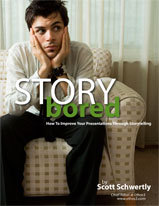 The folks at ethos 3 Communications specialize in using stories in presentations, as evidenced by their blog, Presentation Revolution: Revolutionizing Presentations Through Storytelling.
The folks at ethos 3 Communications specialize in using stories in presentations, as evidenced by their blog, Presentation Revolution: Revolutionizing Presentations Through Storytelling.
They also offer a nifty 22-page book, StoryBored: How to Improve Your Presentations Through Storytelling, as a free download. The booklet has a fun layout/design and lots of great ideas. Here’s what the ethos 3 folks say about it:
Check out the Ethos3 eBook on how to improve your presentations with storytelling. It will take your presentation to the next level. It has all the tips, tricks, and hacks you need to succeed with your next presentation.
One Day, One Job, One Story
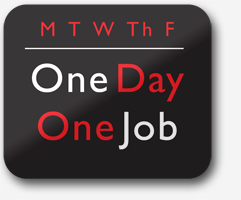
Willy Franzen blogs about entry-level jobs at One Day, One Job in a folksy, story-like way, often providing access to the employer’s own story, such as through video. From the blog’s About page:
Every day we take a look at one employer and the jobs that they are offering for recent college graduates. We scour both online and offline media for information on jobs that you may never think to look for. Too much job seeker attention goes to the top handful of companies that hire at the entry level. We want to open your eyes to the thousands of opportunities available to you, one day at a time.
A Leadership Story
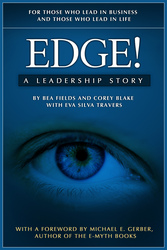 I have long been intrigued with authors who use story to write books in innovative ways (I almost said “novel” ways). I’m interested in business novels, business fables, like Steve Denning’s Squirrel, Inc. and Spencer Johnson’s Who Moved My Cheese?, and some of the others that appear on the sidebar of this blog.
I have long been intrigued with authors who use story to write books in innovative ways (I almost said “novel” ways). I’m interested in business novels, business fables, like Steve Denning’s Squirrel, Inc. and Spencer Johnson’s Who Moved My Cheese?, and some of the others that appear on the sidebar of this blog.
A new entry is Edge! A Leadership Story.
Here’s what the book’s Web site says about its creation:
In May of 2006, Bea Fields approached Corey Blake with an idea. She was recognized as a pioneer in her industry, but she needed a vehicle to really shake people up and challenge them to set higher standards for themselves, their businesses and their lives. She also knew that the way to achieve her goal was to use a story approach that would engage and entertain her readers as much as it would educate them. With a longstanding background in storytelling and developing exceptional content, Corey brought aboard Eva Silva Travers, an accomplished writer, and the three worked over the course of two years to bring you Edge! A Leadership Story.
One of the co-authors, Corey Blake, gives a quick plot summary in the clip below:
Anyone for a Blog Carnival?
In addition to the upcoming Q&As planned for A Storied Career, I’m researching the idea of doing blog carnivals.
Please e-mail me if you might be interested in participating.
Using Stories in Presentations, Part 1
From a terrific list of 250 Things To Improve Your Presentations at Siam English come several items related to storytelling:
- Tell a story, make a point.
- Tell another story, make another point.
- Create a story bank. Each time something interesting happens — big or small — write it down. You never know where you can use it.
- Quoting someone you know gives you the opportunity to tell a story about how the quote came about. Twice the fun for your audience!
- A powerful story has four elements — it makes you think, makes you feel, makes you laugh and most importantly, it delivers a message that can change your life.
- What’s one story that only YOU can tell? Spend time creating that signature story.
- Tell half a story and the proceed with your main message. Make sure your message ties in well with that story and don’t forget to tell the rest of your story at the end of your speech. You won’t want to leave your audience high and dry, will you?
- Tell them enough to whet their appetite but do not reveal the big secret yet. Here’s one you can try: Tell them a story of how a man from the streets became rich and famous overnight without giving them the specifics.
- Smile. Smile when you are walking up to the stage. Smile when you make a mistake. Smile when your audience laughs at your story.
- One story per point. The story doesn’t have to be long. Just make sure it underscores your point.
- Variety keeps your audience on their toes. Find different ways to deliver your content. It could be a story, a videoclip, a demonstration, a pair share, an activity, a guest share, quotes, numbers, graphs, visuals, and the list goes on.
- Stories are only an asset to your speech if you bring your audience into your story through a “U”-centric question. For example, “Have YOU ever stepped on a scale and were forced to face reality?” And then you proceed with your story.
- The above is much better than telling your audience blatantly that you have a story to tell. Also avoid: “Oh, and this remind me of a story…” Equally lame.
Create Stories to Engage Your Supporters
 Colette Ellis of InStep Consulting for Nonprofit Central and Craig’s List Foundation recorded the 18-minute podcast, Once Upon a Time: Create Stories to Engage Your Supporters. It provides tips for nonprofit leaders to create engaging stories that will motivate potential supporters and volunteers (including a model for writing the story). While it is geared toward public-sector organizations, other business leaders may also benefit from the ideas and suggestions.
Colette Ellis of InStep Consulting for Nonprofit Central and Craig’s List Foundation recorded the 18-minute podcast, Once Upon a Time: Create Stories to Engage Your Supporters. It provides tips for nonprofit leaders to create engaging stories that will motivate potential supporters and volunteers (including a model for writing the story). While it is geared toward public-sector organizations, other business leaders may also benefit from the ideas and suggestions.
Weekly Wordle
Two Men Talking … and Teaching about Storytelling
 Both Two Men Talking and the related site narativ are rather spare Web sites into which one must do a bit of digging to see what they’re all about.
Both Two Men Talking and the related site narativ are rather spare Web sites into which one must do a bit of digging to see what they’re all about.
A press release on Two Men Talking explains the origins:
> Murray Nossel and Paul Browde met in 1974 in Johannesburg when they were 12-year-old rival schoolmates and were challenged by a teacher to tell each other a story. Decades later, they met by chance in a New York street and the story has continued, but has become the tale of their own experiences and individual and shared lives. Murray is now an Oscar-nominated filmmaker and Paul a psychiatrist, and their conversation is frank, unsentimental and without boundaries. Within a broadly chronological framework, TWO MEN TALKING examines their shared experiences growing up white, Jewish, gay and privileged under the apartheid regime. Over the many years of performing this show, this unscripted piece has dealt with difficult issues including harassment, homophobia, racism and AIDS, each of which has deeply touched the lives of the two men. Each performance is absolutely unique as the way they tell the story changes in a continually transforming and developing piece. The combination of theatre and real life and has inspired audience members to tell stories of their own, and to better value their own relationships.
 Murray apparently now leads story workshops and seminars with special guest Paul under the name narativ, described this way on the narativ site:
Murray apparently now leads story workshops and seminars with special guest Paul under the name narativ, described this way on the narativ site:
> Discover your Life Story as a source of creative expression. Clearly and confidently communicate who you are + what you do. In an amazingly short time you will learn how to master your own storytelling ability and be taught how to use that skill to succeed in any part of your life, including business and socially.

